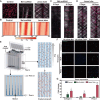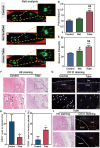Synergistic Biofilter Tube for Promoting Scarless Tendon Regeneration
- PMID: 38833276
- PMCID: PMC11194804
- DOI: 10.1021/acs.nanolett.4c01540
Synergistic Biofilter Tube for Promoting Scarless Tendon Regeneration
Abstract
Inspired by the imbalance between extrinsic and intrinsic tendon healing, this study fabricated a new biofilter scaffold with a hierarchical structure based on a melt electrowriting technique. The outer multilayered fibrous structure with connected porous characteristics provides a novel passageway for vascularization and isolates the penetration of scar fibers, which can be referred to as a biofilter process. In vitro experiments found that the porous architecture in the outer layer can effectively prevent cell infiltration, whereas the aligned fibers in the inner layer can promote cell recruitment and growth, as well as the expression of tendon-associated proteins in a simulated friction condition. It was shown in vivo that the biofilter process could promote tendon healing and reduce scar invasion. Herein, this novel strategy indicates great potential to design new biomaterials for balancing extrinsic and intrinsic healing and realizing scarless tendon healing.
Keywords: biofilter effects; biomedical melt electrowriting; hierarchical structure; scarless tendon healing.
Conflict of interest statement
The authors declare no competing financial interest.
Figures





Similar articles
-
Tendon regeneration and scar formation: The concept of scarless healing.J Orthop Res. 2015 Jun;33(6):823-31. doi: 10.1002/jor.22853. Epub 2015 Apr 27. J Orthop Res. 2015. PMID: 25676657 Free PMC article. Review.
-
An aligned porous electrospun fibrous membrane with controlled drug delivery - An efficient strategy to accelerate diabetic wound healing with improved angiogenesis.Acta Biomater. 2018 Apr 1;70:140-153. doi: 10.1016/j.actbio.2018.02.010. Epub 2018 Feb 15. Acta Biomater. 2018. PMID: 29454159
-
An asymmetric chitosan scaffold for tendon tissue engineering: In vitro and in vivo evaluation with rat tendon stem/progenitor cells.Acta Biomater. 2018 Jun;73:377-387. doi: 10.1016/j.actbio.2018.04.027. Epub 2018 Apr 17. Acta Biomater. 2018. PMID: 29678676
-
From fetal tendon regeneration to adult therapeutic modalities: TGF-β3 in scarless healing.Regen Med. 2023 Oct;18(10):809-822. doi: 10.2217/rme-2023-0145. Epub 2023 Sep 6. Regen Med. 2023. PMID: 37671630 Review.
-
Oriented inner fabrication of bi-layer biomimetic tendon sheath for anti-adhesion and tendon healing.Ther Adv Chronic Dis. 2020 Aug 4;11:2040622320944779. doi: 10.1177/2040622320944779. eCollection 2020. Ther Adv Chronic Dis. 2020. PMID: 32821363 Free PMC article.
Cited by
-
Synergistic Effects of Insulin-like Growth Factor-1 and Platelet-Derived Growth Factor-BB in Tendon Healing.Int J Mol Sci. 2025 Apr 24;26(9):4039. doi: 10.3390/ijms26094039. Int J Mol Sci. 2025. PMID: 40362278 Free PMC article.

